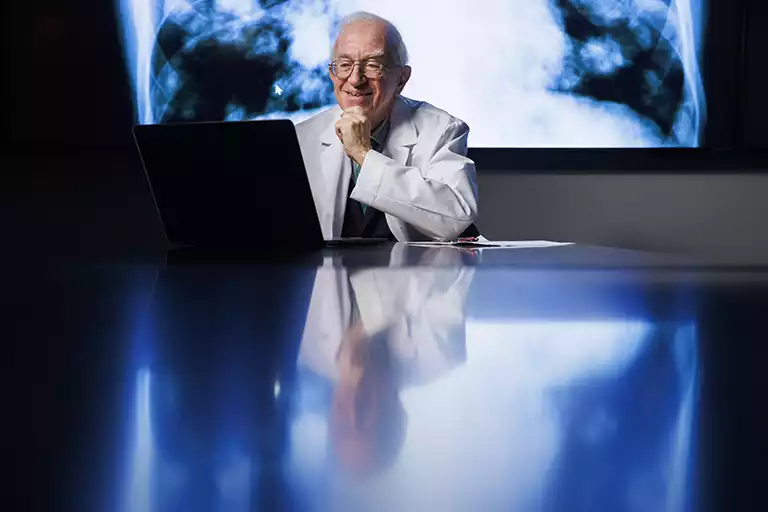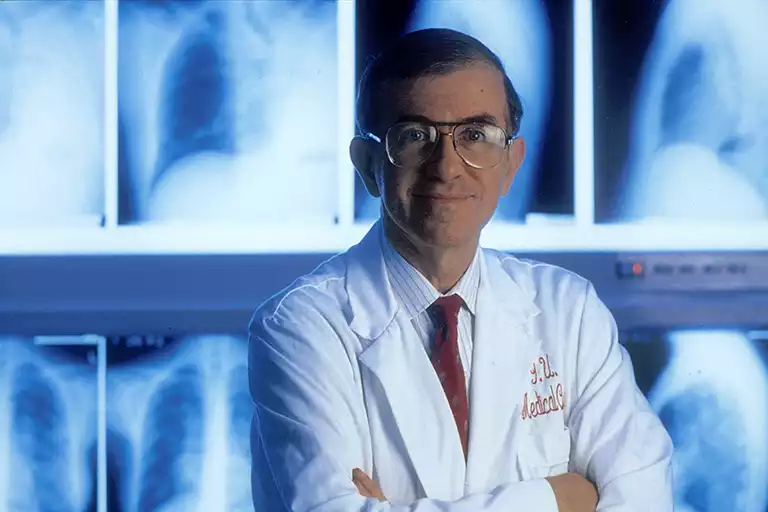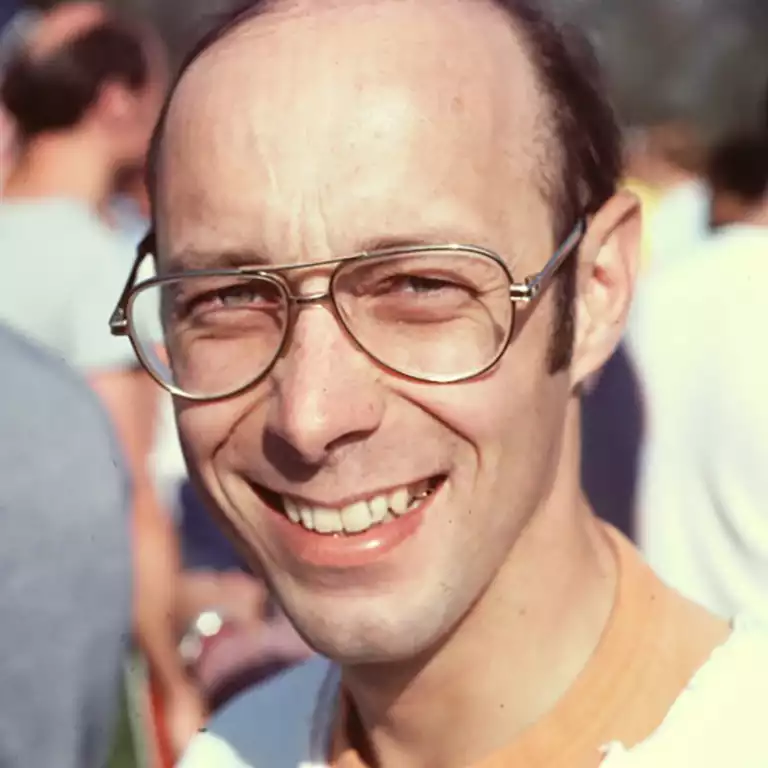By Candace Gwaltney
Sept 16, 2024
50 years of the cure: Celebrating pioneering IU research and the cure for testicular cancer
In 1974, an innovative young oncologist at Indiana University had an idea for a new drug therapy regimen for testicular cancer. Over the past 50 years, that idea has saved hundreds of thousands of lives and is widely considered among the greatest achievements in medicine. That young researcher and his groundbreaking discovery have created a foundation of research excellence at the Indiana University Melvin and Bren Simon Comprehensive Cancer Center.
Survival rates for testicular cancer were a dismal 5% in 1974 when Dr. Lawrence Einhorn enrolled the first patient in a clinical trial to test a new treatment regimen he developed.
“I wasn't expecting to go from a 5% cure rate to 80% cure rate,” said Einhorn, an IU Distinguished Professor. “I don't think any serious investigator thinks that would’ve happened.”
Now more than 95% of all testis cancer patients are cured with surgery or the chemotherapy regimens developed at Indiana University. His discovery also marked a paradigm shift in cancer research everywhere.

“Even in my wildest youthful exuberance, I never dreamed that this type of therapy would have that type of result,” Einhorn said. “It's the Neil Armstrong walk on the moon. You do something like that once in your professional career.”
The magnitude of Einhorn’s discovery is quantifiable not only in the hundreds of thousands of lives saved but also through the ripple effect on dozens of oncologists he has trained and a lasting culture of exceptional research and care at the IU Simon Comprehensive Cancer Center.
Developing the cure
Einhorn joined the IU School of Medicine faculty as the school’s first medical oncologist in 1973, working alongside world-famous urologic surgeon John Donohue, MD. Young patients were already traveling to Indiana University for treatment from Donohue, who was the world leader in the surgical cure for early-stage testicular cancer. The patients who could not be cured with surgery were coming back to see Einhorn for chemotherapy treatments. Thanks to Einhorn and Donohue, IU treated more metastatic testis cancer cases than anywhere else in the world.

“In those days, you were hoping that you could do something for testis cancer and improve a 5% cure rate to 10% cure rate,” Einhorn recalls. At that time, it was widely accepted that if cancer had spread and was not surgically removable, it was not treatable.
In 1974, Einhorn was ready to open a trial with a combination chemotherapy that included the platinum-based drug cisplatin. The drug had failed to effectively stop cancer in previous Phase I clinical trials and was difficult to tolerate due to severe side effects including vomiting, neuropathy, hearing loss and kidney damage. Still, the data showed that a small number of testis cancer patients experienced disease regression.
Einhorn developed a regimen to combine cisplatin with two additional drugs that were effective in killing testis cancer cells.
John Cleland became the first patient on the clinical trial with this platinum combination therapy.
“When John signed that consent form, we knew the side effects of this drug,” Einhorn said. “We had no idea about whether it would have a response, whether it would make him live a couple weeks or a couple months longer, or whether he could even tolerate the therapy. So, it took a great deal of fortitude and courage to sign that consent form. And John said: ‘Maybe this won't help me, but maybe it will help others.’”
The results were astounding. Just three weeks later, when Cleland had a follow-up scan, the cancer that had spread to his lungs was gone. In the coming months and years, the new chemotherapy regimens had similar results in more and more patients.
“As the years went by, we started to realize that this is actually curing a solid tumor for the first time,” Einhorn said. “This was our walk on the moon.”
Pioneering cancer research
This breakthrough made the medical research industry take notice and start investing more resources into oncology research. Five decades later, testicular cancer remains the cancer with the highest cure rate, and cisplatin remains part of first-line therapy for more than a dozen forms of cancer.
“The John Cleland story and the testis cancer story is most pivotal because it got people interested in oncology, including big pharma,” Einhorn said. “There was not much enthusiasm in oncology before testis cancer findings where we actually saw that we can cure some patients with the disease. All of a sudden, you have these brilliant minds who are working with very big budgets and developing these new treatments with immunotherapy and solid tumors.”

Research efforts at IU continued at full speed and haven’t stopped. Einhorn continued to refine the regimen to minimize the toxic side effects and shorten the duration of therapy from two years to 12 weeks to now nine weeks, without lowering the cure rate. For the patients who weren’t cured with the initial platinum-based therapy, Einhorn studied another chemotherapy called etoposide. That study led to a cure for 25% of those patients who didn’t respond to the platinum therapy.
Efforts to improve outcomes for men with testicular cancer have been continuous at the IU Simon Comprehensive Cancer Center. Today testicular cancer is the most curable solid tumor, with about 95% of all testicular cancer eliminated with surgery or cancer drug therapy.
“I have the greatest job in oncology and, actually, the greatest job in medicine,” Einhorn said. “It's a luxury to see a young man who's 25 years old — that's the average age of our patients; they're scared and appropriately scared — and to face some eye-to-eye and say, ‘Everything's going to be OK, and we're almost certainly going to cure your disease.’”
Einhorn described this part of this work as “an awe-inspiring experience.”
Building a culture of compassion
The pioneering research led by Einhorn laid the groundwork for what would become the only National Cancer Institute-designated comprehensive cancer center in Indiana. As the first medical oncologist at IU, Einhorn has seen the cancer center’s exponential growth in research and care. Today he is among more than 300 cancer researchers at the IU Simon Comprehensive Cancer Center.
Einhorn established the IU School of Medicine's Hematology/Oncology Fellowship, one of the oldest programs in the United States, in 1975. For decades he has trained young physicians, many of whom have become standouts in cancer care and research.
Even considering all the advances made in cancer research, colleagues and former fellows often point to Einhorn’s compassion as his legacy.

Nabil Adra, MD, a physician-scientist at the IU Simon Comprehensive Cancer Center, is leading new clinical trials for treatment-resistant testicular cancer. He is a former fellow who has built his practice and research working alongside Einhorn.
“Perhaps most important is he’s had a great impact as far as how to be compassionate,” Adra said. “He has always been very dedicated to his work, very dedicated to his patients, and he's set the tone and set the culture for all of us here at IU to have a similar approach.
“I've also seen how much Dr. Einhorn cares for those patients who he is not able to cure, for the small percentage of patients who unfortunately end up dying of this cancer,” Adra said. “I suspect he's quite frustrated with the fact that he's not able to cure those patients, and I suspect he cares even more deeply about that.”
For decades, patients from around the world have reached out to Einhorn for consultations or come to Indianapolis for treatment. Before the internet, he was surprised by the ways people would find him, but now he’s easy to locate through online searches and forums. He receives an average of 10 messages a day, and he remains committed to answering every single one on the same day it is received.
Einhorn and his team continue to consult directly with patients and their physicians — at no charge — to ensure they are getting the best possible care wherever they are.
“I use that as a teaching exercise for our junior faculty so they can see how I deal with situations and what my thought process is,” Einhorn said. “We are doctors, and we are healers, and we’re here to help people.”
And help people he has. Today, 50 years after the cure was discovered, it is estimated that more than 400,000 lives in the United States alone have been saved thanks to the expertise and compassion of Dr. Lawrence Einhorn.




